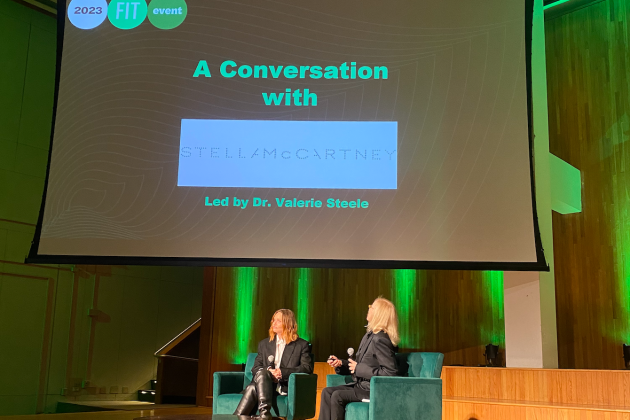Stella McCartney, Fashion’s Favorite ‘Eco Weirdo,’ Talks to FIT Students Ahead of Met Gala
- Oops!Something went wrong.Please try again later.
- Oops!Something went wrong.Please try again later.

Stella McCartney revisited career milestones, vegan leather crusades and more as the self-described “eco-weirdo” spoke to students at FIT Monday afternoon.
The conversation spanned her sustainable fashion career milestones, ongoing policy work, material alternatives, advice to students and the self-provoked “nepo baby” jab tracing the contrasting inspirations from her celebrity parents and life on an organic farm in England.
More from WWD
Jumping right into her childhood, moderator and director of the Museum at the Fashion Institute of Technology, Valerie Steele, asked McCartney where her influence derived.
“One moment, I was on a school bus and living life, and then the next minute I was jetting off to a stadium with 250,000 people and hanging out with David Bowie. So I had this crazy contrast life. If you look at my clothes, it’s really there in my clothes,” she said.
McCartney’s label spans the no-frills, everyday clothing and more feminine inspirations, as well as the un-gendered glam rock stage wear drawing inspiration from her parents’ shared wardrobe.
“I couldn’t tell you whose was whose,” McCartney said of her parents’ interchangeable styles.
From her informal fashion education via close study of her parents, her Savile Row tailoring training, and early days studying fashion at Central Saint Martins — McCartney had a bit of advice for today’s students that’s perhaps counter to what most might tell them.
“Be as naïve as you can for as long as possible,” she told the packed auditorium of fashion hopefuls. “It’s the biggest gift to not take anything seriously. There’s been times where I’ve tried hard to do something that doesn’t come naturally to me have always been not my most successful moments.”
As for her successes? She made an imprint at Chloé and her eponymous label has shaped sustainable fashion.
In her belief, today’s up-and-coming designers must ingrain sustainability in all that they’re doing. Growing up vegetarian and being devoutly antifur and anti-leather in her design career, McCartney hasn’t strayed from her path.
“My privilege wasn’t fame and fortune. That’s not what I was looking for,” she said. “My privilege was in a career choice that I got my foot in the door, obviously, but my privilege was that I could make my own conscious decisions and I could follow through with my ethics.”
Whether it be conscious choices in putting BioSequins (an LVMH prize winner for innovation in bio-based sequins), mycelium innovators or regenerative cotton on the maps, McCartney isn’t done yet.
“At the beginning, it was near impossible,” she said on making fashion sustainable. “I was ridiculed for the majority of my career. First all for being Paul and Linda McCartney’s kid and then for being the person that didn’t use leather and being an ‘eco weirdo,’ as I like to call myself…I still work so closely with my supply chain. We tell them what we need.”
The same could be said for how McCartney is working with biotech firms making alternative materials. Speaking on biotech companies, she added: “They tend to be more scientists or tech people, so they don’t understand what fashion people need.”
McCartney hopes to fill in those education gaps, bringing her same outlaw “anti-fashion” flair to events like the G7 (in hopes to slash leather subsidies on tariffs, which have McCartney paying up to 30 percent more on faux leather imports over animal leather).
In a QR-activated brochure (printed on recycled paper), McCartney spelled out the secrets of how she made her last collection 92 percent sustainable, including the use of leather alternatives and regenerative cotton, and shared other decisions her brand makes to be better for the people, planet and, of course, for animals.
Calling out “big” fashion, she added: “The people in charge need to have a moral compass. That’s the biggest reason I do what I do because I need to prove you can do it differently.”
Best of WWD
